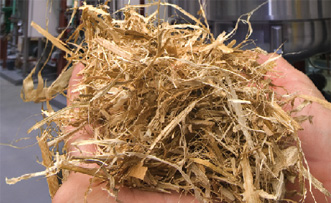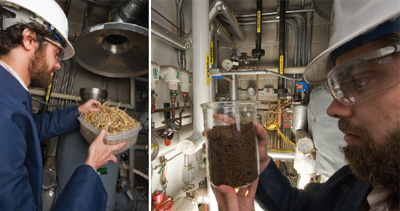
 |
 |
 |
 |
 |
 |
 |
|||
|
|
Squeezing More Sugar from Cellulosic BiomassFrom the 2007 Research Review. 
The non-edible portions of corn, known as corn stover, can be converted into ethanol, but the process is much more difficult than today's processes to convert corn kernels into ethanol. NREL researchers recently achieved an important goal in breaking down long molecular chains of xylan—a significant component of biomass plant material—into their component xylose sugar molecules. This is a very important step toward the goal of making ethanol from cellulosic biomass cost competitive with fossil fuels. Bioenergy technology is focused on taking biomass plant matter apart and making useful products from it. But taking biomass apart can be quite difficult. Over millions of years, plants have evolved highly sophisticated structures to keep themselves intact. Up to 50% of biomass is cellulose and up to 32% is hemicellulose, and these two carbohydrates are nature's main storehouses of sugars that researchers want to tap to make ethanol and other products. Although perhaps the easier of the two to break down, hemicellulose is by no means easy to take apart. It consists largely of xylan, long molecular chains of xylose sugar molecules, which are wrapped around cellulose to protect it. To make cellulosic ethanol cost competitive by 2012, which is a goal of the President's Advanced Energy Initiative, NREL developed a set of specific annual goals for various aspects of biomass conversion technology. A key goal for 2007 was to be able to convert 75% of xylan to xylose. To do that, NREL used a dilute acid, high temperature, and pressure to "pretreat" biomass, breaking down the hemicellulose and making the cellulose more accessible for the next step in the process, called enzymatic hydrolysis. 
Researcher Noah Weiss feeds raw corn stover into a pretreatment reactor (left) and examines the product (right) after the reactor has extracted the hemicellulose as xylose. Pretreatment expert Nick Nagle describes realizing the 75% xylan conversion goal—up from 63% the previous year—as "a big step in the right direction." And fellow researcher Andy Aden says it was a great challenge for a number of reasons. "One, we are now working at 30% solids—kind of like oatmeal or paste—which is much more difficult than our earlier work with more free liquid, but it's also a key step toward making the overall process economically competitive," says Aden. "Two, our research has shown that the xylan release process occurs in two distinctly different segments, with the first step occurring swiftly and the second occurring much more slowly. This was the first really big gain with xylan release that draws on the slower, more difficult second step." Key steps included thoroughly impregnating the biomass with acid before putting it into the pretreatment reactor and then reducing the actual reactor time to less than two minutes. The shorter time in the reactor limited the subsequent degradation of the xylose. The goal for 2008 is to move from a batch process to a continuous reactor, while the ultimate goal is to reach 90% conversion by 2012. 
This technology is in the Technology Development phase of the R&D process. Learn more in "From Research Discoveries to Market: Five Steps to Commercialization." |
| NREL is a national laboratory of the U.S. Department of Energy, Office of Energy Efficiency and Renewable Energy, operated by the Alliance for Sustainable Energy, LLC |